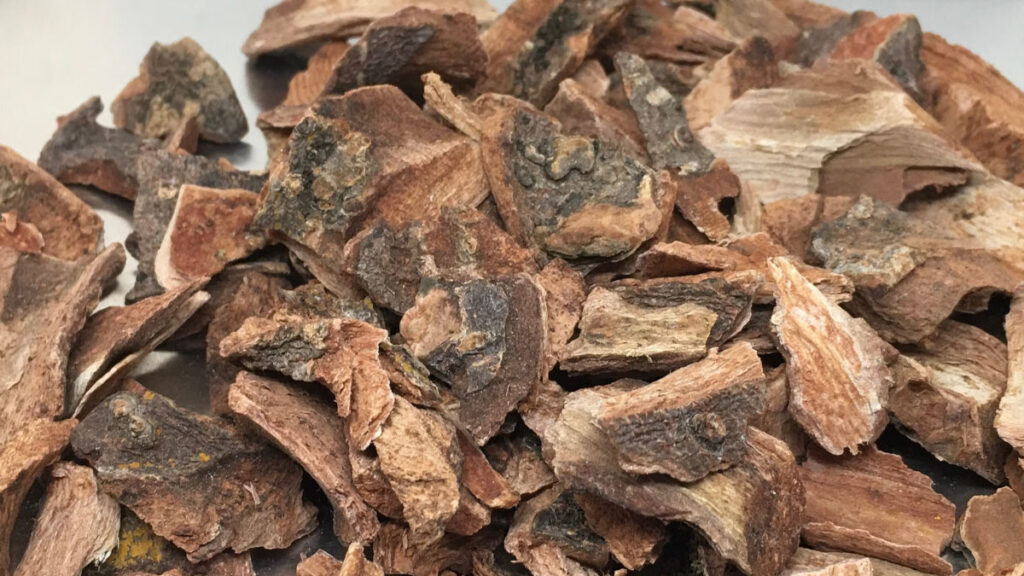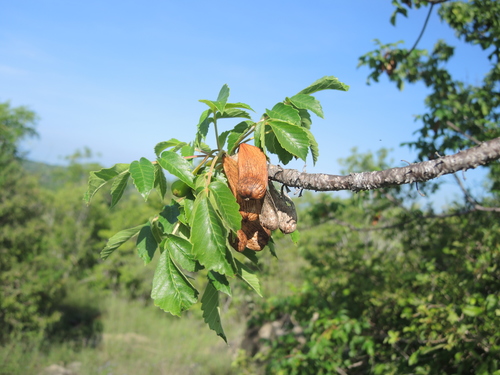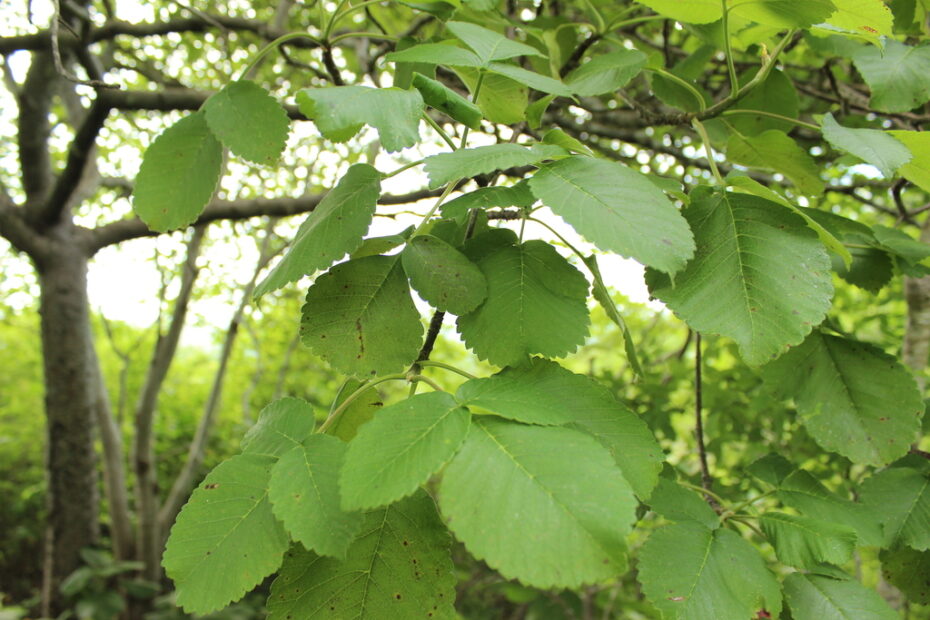Botanical Information
- Scientific Name: Amphipterygium adstringens (Schiede ex Schlecht)
- Family: Julianiaceae
- Common Names: Cuachalalate, Cuauchachalatli (Nahuatl), Cuachalala, Volador, Palo Santo, Cáscara
- Plant Type: Resinous, dioecious tropical tree
- Native Range: Central and southern Mexico, Guatemala, Nicaragua, Honduras
- Habitat: Dry, rocky hillsides, tropical jungles, deciduous forests at 100–1,700 meters above sea level
- Conservation Status: Endangered since 2004 due to overharvesting of bark
Description
Cuachalalate is a broad-leaved tree, typically 4–8.5 meters tall, occasionally reaching 18 meters. Its grayish, wrinkled, verrucose bark with corky protuberances is rich in tannins. The tree has imparipinnate leaves with 3–7 leaflets, featuring a cuneate base, dentate or crenate margins, and spathulate terminal leaflets. Branches often bear scars from fallen leaves and may have fine hair-like structures. Small flowers bloom from July to August, with fruiting until January.
Traditional Uses
Cuachalalate is a cornerstone of Mexican herbal medicine, valued for its bark. Historically used during the Mexican Revolution to treat wounds and prevent scarring, it is prepared as a tea, tincture, or tonic for:
- Digestive Issues: Gastritis, gastric ulcers, stomach cancer, colitis, indigestion
- Circulatory Health: Blood purification, oxygen flow, varicose veins
- Oral Health: Toothache, gingivitis, mouth ulcers, gum hardening
- Infections: Kidney infections, urinary tract infections, typhoid fever, malaria
- Inflammatory Conditions: Colitis, arthritis, other inflammatory disorders
- Other Uses: Liver problems, gall bladder stones, diabetes, fever, skin conditions (acne, wounds, insect bites), women’s health (ovarian/uterine infections), respiratory conditions (coughs, colds, tuberculosis)

Herbal Formulas
Below are detailed herbal formulas incorporating cuachalalate for various health purposes:
1. Digestive Health Tea
- Purpose: Soothes gastritis, ulcers, and indigestion
- Ingredients:
- 2 tbsp Cuachalalate bark (chopped or shaved)
- 1 tbsp Dandelion root (Taraxacum officinale)
- 1 tsp Fennel seeds (Foeniculum vulgare)
- 1 tsp Marshmallow root (Althaea officinalis)
- 16 oz water
- Preparation:
- Combine all herbs in a pot with water.
- Bring to a boil, then reduce to a simmer for 15 minutes.
- Strain and drink 1 cup twice daily, hot or cold.
- Notes: Consume before meals for best results.
2. Anti-Inflammatory Tonic
- Purpose: Reduces inflammation in conditions like colitis or arthritis
- Ingredients:
- 1 tbsp Cuachalalate bark
- 1 tbsp Turmeric root (Curcuma longa)
- 1 tsp Ginger root (Zingiber officinale)
- 12 oz water
- Honey or Agave to taste (optional)
- Preparation:
- Simmer cuachalalate, turmeric, and ginger in water for 10–12 minutes.
- Strain, add honey or agave if desired, and drink 1 cup daily.
- Notes: Use fresh turmeric and ginger if available for enhanced potency.
3. Oral Health Rinse
- Purpose: Treats mouth ulcers, gingivitis, and toothaches
- Ingredients:
- 1 tbsp Cuachalalate bar
- 1 tsp Chamomile flowers (Matricaria chamomilla)
- 8 oz water
- Preparation:
- Steep cuachalalate and chamomile in boiling water for 10 minutes.
- Strain, cool to room temperature, and use as a mouthwash 2–3 times daily.
- Notes: Swish for 30 seconds and spit out; do not swallow.
4. Topical Wound Salve
- Purpose: Promotes healing of wounds, sores, or insect bites
- Ingredients:
- 2 tbsp Cuachalalate bark powder
- 1 tbsp Plantain leaf powder (Plantago major)
- 2 oz coconut oil or beeswax base
- Preparation:
- Melt coconut oil or beeswax in a double boiler.
- Mix in cuachalalate and plantain leaf powders until fully blended.
- Pour into a clean container, let cool, and apply to affected areas 1–2 times daily.
- Notes: Perform a patch test to ensure no allergic reactions.
5. Immune-Boosting Infusion
- Purpose: Supports immune response for infections or general wellness
- Ingredients:
- 1 tbsp Cuachalalate bark
- 1 tbsp Elderberry (Sambucus nigra)
- 1 tsp Astragalus root (Astragalus membranaceus)
- 16 oz water
- Preparation:
- Simmer all ingredients in water for 15 minutes.
- Strain and drink 1 cup daily during cold/flu season or infections.
- Notes: Consult a healthcare provider if on immunosuppressive medications.
Phytochemical Composition
Cuachalalate’s bark contains:
- Triterpenes: Masticadienonic acid, α-hydroxymasticadienonic acid, masticadienonic/isomasticadienonic acid mixtures (higher in female trees)
- Tannins: Polymeric tannins with antimicrobial and anti-inflammatory properties
- Anacardic Acids: Anti-quorum sensing activity against bacteria like Pseudomonas aeruginosa
- Antioxidants: Quercetin, kaempferol, protecting against oxidative stress
- Other Compounds: Lupeol, oleanolic acid (analgesic properties)

Pharmacological Properties
Scientific studies validate:
- Anti-inflammatory: Ethanolic extracts reduce proinflammatory cytokines (TNF-α, IFN-γ, IL-1β) and enhance antioxidant enzymes (SOD, GPx) in colitis models.
- Gastroprotective: Methanol extracts protect gastric mucosa from NSAID-induced damage.
- Antimicrobial: Inhibits bacterial quorum sensing, reducing virulence in pathogens like Pseudomonas aeruginosa.
- Immunostimulant: Aqueous extracts enhance immune response in lymphoma-bearing mice.
- Anticancer Potential: Boosts immune response to inhibit tumour growth.
- Analgesic: Lupeol and oleanolic acid reduce pain from headaches or cramps.
- Antioxidant: Reduces oxidative stress, potentially lowering chronic disease risk.
Safety and Precautions
- Pregnancy and Lactation: Avoid due to lack of safety data.
- Consultation: Consult a healthcare professional before use, especially for self-diagnosis.
- Sustainability: Source from sustainable suppliers due to endangered status.
- Side Effects: May cause initial stinging for ulcers; no significant adverse effects reported.
Cultural and Historical Significance
- Nahuatl Origins: Named “Cuauchachalatli” in Aztec language.
- Mexican Revolution: Used to treat wounds, preventing scarring.
- Dye Production: Bark tannins produce a red dye.
- Dr. Sebi’s Advocacy: Featured in his Stomach Relief Tea for digestive and immune support.
Commercial Availability
Available as raw bark, powder, capsules (400–450 mg), or tea from suppliers like Evergreen Herbs, Tadin Herb & Tea Co., and Naturejam.
Research and Future Potential
Studies highlight cuachalalate’s potential for inflammatory colitis, gastric ulcers, bacterial infections, and anticancer applications. Sustainable harvesting is critical for future use.
References
- Navarrete, A., et al. (2002). “Gastroprotective effect of Amphipterygium adstringens.” Journal of Ethnopharmacology, 82(1), 7–13.
- Oviedo-Chávez, I., et al. (2004). “Antimicrobial activity of Amphipterygium adstringens.” Fitoterapia, 75(7-8), 689–691.
- Romero-Cerecero, O., et al. (2012). “Anti-inflammatory activity of Amphipterygium adstringens in a mouse model of colitis.” Inflammopharmacology, 20(3), 153–159.
- Web sources:
- https://www.herbco.com/p-1126-cuachalalate-bark.aspx
- https://www.amazon.com/Cuachalalate-Bark-Herb-Tea-Oz/dp/B01N2W6J5K
- https://www.mexicanherbco.com/cuachalalate
- https://www.webmd.com/vitamins/ai/ingredientmono-1653/cuachalalate
- https://www.healthline.com/nutrition/cuachalalate-benefits
- X post: @HerbalRemedyX (2024): “Cuachalalate tea for ulcers and inflammation—traditional Mexican remedy with science-backed benefits.”
- Statements regarding dietary supplements have not been evaluated by the FDA and are not intended to diagnose, treat, cure, or prevent any disease or health condition.
This article is copyrighted by Ital is Vital, 2025. Want to re-post this article? Visit our guidelines.
DISCLAIMER: THIS WEBSITE DOES NOT PROVIDE MEDICAL ADVICE
The information, including but not limited to, text, graphics, images and other material contained on this website are for informational purposes only. The purpose of this website is to promote broad consumer understanding and knowledge of various health topics. It is not intended to be a substitute for professional medical advice, diagnosis or treatment. Always seek the advice of your physician or other qualified health care provider with any questions you may have regarding a medical condition or treatment and before undertaking a new health care regimen, and never disregard professional medical advice or delay in seeking it because of something you have read on this website.
